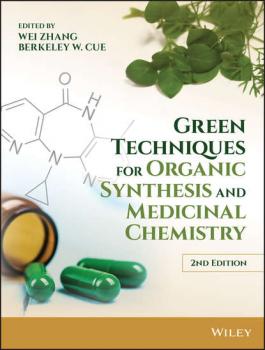Wei Zhang
Список книг автора Wei ZhangGreen Techniques for Organic Synthesis and Medicinal Chemistry
An updated overview of the rapidly developing field of green techniques for organic synthesis and medicinal chemistry Green chemistry remains a high priority in modern organic synthesis and pharmaceutical R&D, with important environmental and economic implications. This book presents comprehensive coverage of green chemistry techniques for organic and medicinal chemistry applications, summarizing the available new technologies, analyzing each technique’s features and green chemistry characteristics, and providing examples to demonstrate applications for green organic synthesis and medicinal chemistry. The extensively revised edition of Green Techniques for Organic Synthesis and Medicinal Chemistry includes 7 entirely new chapters on topics including green chemistry and innovation, green chemistry metrics, green chemistry and biological drugs, and the business case for green chemistry in the generic pharmaceutical industry. It is divided into 4 parts. The first part introduces readers to the concepts of green chemistry and green engineering, global environmental regulations, green analytical chemistry, green solvents, and green chemistry metrics. The other three sections cover green catalysis, green synthetic techniques, and green techniques and strategies in the pharmaceutical industry. Includes more than 30% new and updated material—plus seven brand new chapters Edited by highly regarded experts in the field (Berkeley Cue is one of the fathers of Green Chemistry in Pharma) with backgrounds in academia and industry Brings together a team of international authors from academia, industry, government agencies, and consultancies (including John Warner, one of the founders of the field of Green Chemistry) Green Techniques for Organic Synthesis and Medicinal Chemistry, Second Edition is an essential resource on green chemistry technologies for academic researchers, R&D professionals, and students working in organic chemistry and medicinal chemistry.
Microarray Quality Control
Microarray technology provides researchers in the life sciences with a revolutionary tool for measuring gene expression. However, this highly developed process involves multiple steps, from sample selection to data analysis, each susceptible to potentially costly errors. Without sound quality control, experimental microarrays may produce useless or, even worse, misleading results. Microarray Quality Control provides a comprehensive resource for ensuring quality control in every step of this complex process. From experimental design to data processing, analysis, and interpretation, the emphasis in this text remains on practical advice for each stage of planning and running a microarray study. Chapters cover: * Quality of biological samples * Quality of DNA * Hybridization protocols Scanning * Data acquisition * Image analysis * Data analysis Written for the broad group of workers-biologists, mathematicians, statisticians, engineers, physicians, and computational scientists-involved in microarray studies, Microarray Quality Control features a straightforward style easily accessed by various disciplines. Useful checklists and tips help ensure the integrity of results, and each chapter contains a thorough review of pertinent literature. The only complete, systematic treatment of the topic available, Microarray Quality Control offers students and practitioners an invaluable resource for improving experimental quality and efficiency.
Dynamic Covalent Chemistry. Principles, Reactions, and Applications
The first and only exhaustive review of the theory, thermodynamic fundamentals, mechanisms, and design principles of dynamic covalent systems Dynamic Covalent Chemistry: Principles, Reactions, and Applications presents a comprehensive review of the theory, thermodynamic fundamentals, mechanisms, and design principles of dynamic covalent systems. It features contributions from a team of international scientists, grouped into three main sections covering the principles of dynamic covalent chemistry, types of dynamic covalent chemical reactions, and the latest applications of dynamic covalent chemistry (DCvC) across an array of fields. The past decade has seen tremendous progress in (DCvC) research and industrial applications. The great synthetic power and reversible nature of this chemistry has enabled the development of a variety of functional molecular systems and materials for a broad range of applications in organic synthesis, materials development, nanotechnology, drug discovery, and biotechnology. Yet, until now, there have been no authoritative references devoted exclusively to this powerful synthetic tool, its current applications, and the most promising directions for future development. Dynamic Covalent Chemistry: Principles, Reactions, and Applications fills the yawning gap in the world literature with comprehensive coverage of: The energy landscape, the importance of reversibility, enthalpy vs. entropy, and reaction kinetics Single-type, multi-type, and non-covalent reactions, with a focus on the advantages and disadvantages of each reaction type Dynamic covalent assembly of discrete molecular architectures, responsive polymer synthesis, and drug discovery Important emerging applications of dynamic covalent chemistry in nanotechnology, including both material- and bio-oriented directions Real-world examples describing a wide range of industrial applications for organic synthesis, functional materials development, nanotechnology, drug delivery and more Dynamic Covalent Chemistry: Principles, Reactions, and Applications is must-reading for researchers and chemists working in dynamic covalent chemistry and supramolecular chemistry. It will also be of value to academic researchers and advanced students interested in applying the principles of (DCvC) in organic synthesis, functional materials development, nanotechnology, drug discovery, and chemical biology.





